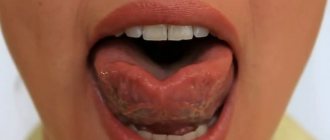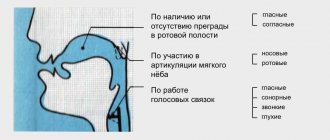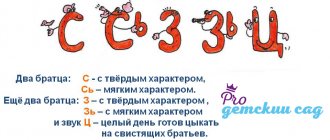N, Sh. M, [x'1;
occlusive fricatives (affricates) [ts], [h];
trembling (vibrants) |р], [р']
(see Fig. 5).
Consonant sounds are formed by creating a barrier in the oral cavity. There are five main types of barriers (a bow exploded by an air stream; a bow with the simultaneous passage of air; a gap into which an air stream passes; a bow that turns into a gap; a barrier formed by a tense tip of the tongue vibrating under the pressure of an air stream). The largest number of consonant sounds in the Russian language according to the method of formation are fricative, in which the movable organs of the articulatory apparatus, approaching the stationary ones, form a gap. It is they and the sounds that include the element of the gap (cleft-cleft and tremulous) that are most often disrupted, since for children the creation of an obstacle in the form of a gap is the most difficult due to the inability to use visual and kinesthetic control. In this group of sounds, [f], [f'], [v], [v'] are usually not violated, since the child sees their articulation (visual control) and easily feels the directed air stream with the back of his hand (tactile control). The teacher’s work on these sounds creates the basis for the speech therapist’s correctional work on fricative sounds.
Classification of consonant sounds by place of formation:
labiolabial [p], [p'], [b], [b'], [m], [m']; labiodental [f], [f'], [v], [v'];
* The sounds highlighted in this way here and below are violated most often.
anterior lingual (formed by the front part of the back of the tongue, with different positions of the tip of the tongue), the tip of the tongue at the top - [t], [d], [n], [l] , [l'], [r], [r'], [ w], [f], [sch], [h];
tip of the tongue below - [t'], [d'], [n'], [s], [s'], [z], [z'], [ts];
middle language [jj;
back-lingual [k], [k'], [g], [g'j, [x], [x']
(see Fig. 6).
All disrupted sounds in children belong to the lingual group, of which the most frequently disrupted sounds are in the anterior lingual group. This is due to more subtle, differentiated movements of this part of the back of the tongue, forming various barriers (bow - [t], [t'], [d], [d']; bow with simultaneous passage of air - [n], [n'] , [l], [l']; vibration - [r], [r']; gap - [w], [g], [sch], [s], [s'], [z], [z ']; a bow that goes into a gap - [h], [ts]). In this case, the front part of the back of the tongue can work simultaneously with the tip of the tongue: both the tip and the front part of the back of the tongue rise upward ([t], [d], [n], [l], [l'], [r], [r '], [w], [g], [sch], [h]) or the tip of the tongue is located behind the lower teeth (incisors), and the front part rises up and forms a barrier with the alveoli ([t'], [d'] , [n'], [s], [s'], [z], [z'], [c]). Therefore, some children may be challenged by the first group of sounds, others by the second, and in some cases by both groups. In this group of sounds, [t], [t'], [d], [d'], [n], [n'] are usually not violated, since they are explosive, instantaneous, it is easier for children to pronounce them. The teacher’s work on these sounds creates the basis for the speech therapist’s corrective work on all front-lingual sounds.
Soft foods contributed to the spread of labiodental consonants
Rice.
1. In the Late Paleolithic and Mesolithic, adults were characterized by a straight bite (edge-to-edge bite), in which the incisors meet at the edges (
A
- 30-year-old woman, late Paleolithic, Italy;
B
- 30-year-old woman, Mesolithic , Romania).
Since the Neolithic, an “orthognathic” bite, in which the upper incisors overlap the lower ones, has become more common in adults (overbite and overjet; C
- 40-year-old man, early Bronze Age, about 3600 years ago, Austria).
Photo from the discussed article in Science
; diagram of incisor closure in orthognathic occlusion taken from en.wikipedia.org
It is generally accepted that the set of phonemes in a language is in no way connected with the anatomical features of the speech apparatus of its speakers. A group of linguists led by Balthasar Bikel at the University of Zurich has questioned this view. Data from paleoanthropology, biomechanical modeling, ethnography, and historical linguistics analyzed by the researchers are consistent with the hypothesis that changes in occlusion associated with the advent of agriculture and the increase in the proportion of soft foods in the diet contributed to the spread of labiodental consonants, such as in
and
f
.
Today there are about 7,000 languages in the world. The sets of phonemes in languages are very diverse. Moreover, some phonemes (for example, a
or
m
) are used in most languages, while others are used only in a few (for example, the click consonants characteristic of the Khoisan languages).
It is generally accepted that differences in phonetic systems of different languages are in no way related to the anatomical features of the speech apparatus of their speakers. This point of view seems logical, given that the features that make articulate speech possible (such as a drooping larynx, a “modern” shaped hyoid bone, and fine control of breathing, as measured by the width of the spinal canal) were essentially formed half a million years ago and since Since then, apparently, they have not undergone major changes (see: S. Burlak. The origin of language).
However, not all experts agree with this. In 1985, American linguist Charles F. Hockett drew attention to the almost complete absence of labiodental (labiodental) consonants, such as f
and
in
, in hunter-gatherer languages.
Hockett suggested that this was due to their diet affecting their bite. The need to chew rough food contributes to tooth wear and growth of the lower jaw, which leads to the formation of an edge-to-edge bite (Fig. 1, A, B). With such a bite, it is inconvenient to pronounce labiodental consonants due to the large distance between the lower lip and the upper incisors (to pronounce v
or
f
, the lower lip must touch the upper incisors).
With the spread of agriculture, people began to eat more soft foods. The stress on the jaws has decreased, and people have become more likely to have an “orthognathic” bite, in which the upper incisors partially overlap the lower ones (Figure 1 C).
This makes it easier to pronounce the sounds v
and
f Hockett's idea was that labiodental consonants began to spread due to the transition to a productive economy and the growing share of soft foods (cereals, bread, dairy products, boiled vegetables) in the diet of farmers and pastoralists (CF Hockett, 1985. Distinguished Lecture: F).
The idea was initially met with skepticism. The facts available at that time did not allow us to speak confidently about the decisive role of diet in the formation of occlusion. Critics also noted that the incidence of dentition did not begin to decline immediately after the advent of agriculture, but much later.
In a paper published March 15 in the journal Science
, an international team of linguists led by Balthasar Bickel from the University of Zurich presented new arguments in favor of Hockett's hypothesis. An important advantage of the work under discussion is that the authors tried to approach the problem from several different angles at once.
Firstly,
they reviewed current evidence on compensatory modifications to the teeth and mandible that occur with tooth wear. These data indicate that the heavy wear and tear typical of hunter-gatherers does indeed lead to the formation of an overbite (see, for example, Y. Kaifu, 2000. Tooth wear and compensatory modification of the anterior dentoalveolar complex in humans). In children and adolescents, the upper incisors tend to overlap the lower incisors (Figure 1, overbite and overjet). In most modern human populations that eat mainly soft foods, this condition (“orthognathic occlusion”) persists into adulthood. Dentists consider it “normal”, standard. However, if the teeth are subject to severe wear and tear, as happens when there is an abundance of difficult-to-chew foods in the diet, then as people grow older, a straight bite develops. This is typical for Upper Paleolithic sapiens, and even for such ancient representatives of the human race as people from Dmanisi (A. Margvelashvili et al., 2013. Tooth wear and dentoalveolar remodeling are key factors of morphological variation in the Dmanisi mandibles).
Secondly,
the authors tested whether occlusion actually influences the ease of pronunciation of labiodental consonants. The test was carried out using biomechanical modeling in the ArtiSynth program, specially developed for solving such problems (JE Lloyd et al., 2012. ArtiSynth: A Fast Interactive Biomechanical Modeling Toolkit Combining Multibody and Finite Element Simulation). The authors took a previously developed virtual three-dimensional model of the head with an orthognathic bite (with all the associated bones, teeth and muscles) and created on its basis another model - with a direct bite. Both models were forced to perform the movements required to produce different sounds, while monitoring the force with which different muscles had to tense (Figure 2).
Rice.
2. On the left
- modeling of the pronunciation of a labiodental sound (
v
or
f
) with an orthognathic bite (the upper incisors overlap the lower ones),
on the right
- the same with a direct bite (the incisors touch the edges).
Stills from videos (video 1, video 2) attached to the article discussed in Science
The modeling confirmed Hockett’s guess. It turned out that labiodental sounds are indeed easier to pronounce with an orthognathic bite. The total amount of muscle effort required to pronounce them is reduced by almost a third compared to a direct bite. Similar labialial (bilabial) consonants such as b
and
p
, on the contrary, is a little easier to pronounce with a straight bite. Labiodental consonants are more “labor-intensive” than labiolabial consonants in both occlusions, but the difference in labor costs is significantly reduced when the upper incisors overlap the lower ones.
The modeling also showed that with orthognathic occlusion the frequency of errors should increase when, instead of a labiolabial sound, a labiodental sound is accidentally pronounced (for example, in
instead of
b
).
This is evident from the fact that with an orthognathic bite, the relative position of the lips and teeth at the moment of pronouncing a labio-labial sound is closer to that when pronouncing a labio-dental sound than with a direct bite. For example, if a person has an orthognathic bite, then when he says b
, his lower lip comes very close to the central upper incisors.
Just a small inaccuracy is enough for the lip to touch the incisors, and then instead of b
you will get
c
.
If the bite is straight, then when pronouncing the sound b,
the lower lip does not come so close to the upper incisors, and therefore the likelihood of accidentally pronouncing the labiodental sound
c
will be lower. It is known that when the upper teeth overlap the lower teeth very strongly (deep bite, considered “wrong”), people may have problems pronouncing labio-labial sounds, which in such cases are sometimes replaced by similar labio-dental sounds.
Thus, the results of biomechanical modeling are consistent with the hypothesis that changes in occlusion (from straight to orthognathic) may have contributed to the emergence and spread of labiodental consonants. The authors suggest that labiodental consonants were repeatedly “derived” from labiolabials as a result of repeated random errors, which sometimes began to be copied and became the norm in a given language. This idea is consistent with the data of historical linguistics: apparently, labiolabials actually turned out to be the “ancestors” of labiodentals more than once. For example, f
in English
father
is a derivative state compared to the more "primitive"
p
in Italian
padre
.
In general, labiodentals are much more common than labiodentals: p
is present in 87% of languages,
b
in 71%,
f
in 49%,
v
in 37% (all other labiodental consonants are relatively rare: each of them occurs in no more than 2% of languages).
Third approach
used by the authors to test Hockett’s hypothesis, is based on an analysis of the distribution of labiodental consonants in the languages of different peoples depending on their way of life (Fig. 3).
Rice. 3.
Occurrence of labiodental consonants in the languages of hunter-gatherers and peoples with a productive economy (according to data from the PHOIBLE database).
Each dot
corresponds to one language.
Figure from the discussed article in Science
It turned out that in the languages of hunter-gatherers, labiodental consonants are found approximately four times less often than in the languages of peoples with a productive economy. The authors tried many different statistical methods, models, and corrections (including “phylogenetic” corrections for language relatedness and “geographic” corrections for spatial proximity). We tried to look at the data separately by region; they tried to exclude Australia, where labiodentals are almost completely absent in the aboriginal languages. The positive association between productive economy and the occurrence of labiodental consonants remained statistically significant in all cases.
Moreover, if a hunter-gatherer language does have one or two labiodental consonants, there is almost always reason to believe that these phonemes entered the language as a result of contact with other peoples. For example, the indigenous people of Greenland have three dialects: Northern, Southwestern and Eastern. In the northern and eastern dialects, whose speakers had little contact with Europeans, there are no labiodental consonants. Since the 18th century, speakers of the southwestern dialect often communicated with people from Denmark, Germany and Norway. This dialect has a labiodental consonant sound, almost certainly borrowed from Danish, with some members of the older generation still pronouncing this sound as a labiolabial. A similar pattern is observed among the South and East African hunter-gatherers speaking the Khoisan languages: some of these languages received labiodental consonants from their Bantu-speaking neighbors. The Khoisan languages apparently did not have their own original labiodental consonants, although in general these languages are characterized by a wide variety of consonant sounds.
It would be interesting to compare the occurrence of labiodental consonants with the prevalence of different bites among speakers of the corresponding languages, but the authors were unable to obtain such data. The fragmentary evidence available is consistent with the idea that the occlusion is much more common among hunter-gatherers than among farmers and herders.
Fourth approach
consisted of an analysis of the evolutionary tree of the languages of the Indo-European family, which has now been reconstructed reliably enough to be used to try to reconstruct the history of labiodental consonants.
The authors used data from historical linguistics, which make it possible to identify 10 groups of “related” (ever changing into each other or having a “common ancestor”) phonemes, including at least one labiodental consonant. For example, the group designated *p combines the English phoneme f
and Italian
p,
and the group *gw includes English
k
and Italian
v
(English
come
and Italian
venire
to be derived from Proto-Indo-European
*gwem
)
.
For each of these 10 groups, at each point in the Indo-European family tree, the probability that the group had a labiodental phoneme at that point was calculated.
Calculations have shown that in the most ancient Indo-European languages, the occurrence of labiodental consonants was minimal. The probability of the presence of labiodental consonants begins to slowly increase between 6000 and 4000 years ago (or, using an alternative family tree, 4500 and 3500 years ago). Judging by archaeological data, 3,500 years ago, Indo-European peoples were already widely using cereals and dairy products (and the origins of these traditions most likely go deeper into the past).
About 2500 years ago (this date no longer depends on the version of genealogy used) the rapid spread of labiodental consonants began. This process is most strongly expressed in the Italo-Celtic, Germanic and Greek branches, that is, among the Europeans. Researchers presumably attribute this to the spread of water mills and the beginning of large-scale flour production, which should have dramatically reduced the load on the jaws of the then European population.
The authors also mention previously expressed ideas about possible social mechanisms of phonetic change. Such changes could be spurred by the fact that some variant of pronunciation became a sign of high social status (W. Labov, 2001. Principles of Linguistic Change, Volume 2: Social Factors). For example, if we assume (purely hypothetically) that at some point among the rich Greeks, who ate especially soft food and therefore had an orthognathic bite, it became fashionable to pronounce in
instead of
b
, then this refined aristocratic accent could subsequently, thanks to imitation, spread to all native speakers.
In general, the authors managed to build a fairly coherent and convincing system of argumentation. The finding that the expansion of labiodental consonants was associated with the spread of soft foods, which in turn was driven by cultural and technological innovations (agriculture, pottery, mills), contrasts with the prevailing views that evolution languages is not associated with either the biological or cultural evolution of human populations.
There can hardly be any doubt that this research will be met with hostility by many linguists (as was the case, for example, with the work described in the news Languages, like genes, come from Africa, “Elements”, 04/20/2011 ).
On the one hand, the work attempts to explain the patterns of language evolution by reasons “external” to linguistics as such. Such ideas often cause rejection among specialists. This effect is discussed in Kirill Eskov’s book “The History of the Earth and Life on It” using the example of the impact theory of the Cretaceous-Paleogene extinction. For a biologist, the fall of an asteroid is an “extraneous” cause, external to the subject of his study, that is, to the Earth’s biosphere. Therefore, the impact theory was initially perceived by many biologists as an attempt to “multiply existing things without necessity.”
On the other hand, the work under discussion is a broad and bold generalization, based, among other things, on the analysis of large data sets (such as PHOIBLE - a database on the phonetics of languages). When compiling such databases, simplifications and some degree of subjectivity are inevitable. This should not necessarily lead to false conclusions, however, such a bold approach to controversial, complex and very important issues for them often causes rejection among narrow specialists. Various global correlations are also often sharply criticized by specialists who are ready to immediately cite a dozen examples that “refute” a given correlation (refusing statistical patterns with individual examples is perhaps not the best idea, but this rarely stops anyone).
Let's hope that the criticism to which the work under discussion will be subjected will still be constructive, so that as a result our understanding of the mechanisms of language evolution will become more complete.
Source:
D. E. Blasi, S. Moran, S. R. Moisik, P. Widmer, D. Dediu, B. Bickel.
Human sound systems are shaped by post-Neolithic changes in bite configuration // Science
. 2021. V. 363. eaav3218. DOI: 10.1126/science.aav3218.
See also:
1) Linguistic evolution is similar to biological evolution, “Elements”, 10/18/2007. 2) One of the engines of language evolution could be the uneven distribution of linguistic units, “Elements”, 05/06/2010. 3) Men bring a new language, “Elements”, 09/14/2011. 4) Languages, like genes, come from Africa, “Elements”, 04/20/2011.
Alexander Markov
Symptoms
Children's speech is almost never clear right away. Violations in sound pronunciation are gradually eliminated spontaneously due to articulation practice, improving the movements of the speech organs with the age of the child. You can talk about the disease only after preschoolers reach 4 years of age.
Dysfunction can be determined by the following phonetic and physiological symptoms:
- S and Z are not pronounced clearly. Instead, similar interdental phonemes are heard with the overtones D, T, soft Sh, Zh.
Goat - pronounced as koza, scythe - kotsa, dog - tabaka, live - divut, etc.
- Whispering, ugly articulation N-W.
The tongue sticks between the teeth. The defect is visible to the eye.
- Nasal sound during phonation.
Nasal articulation is due to the immobility of the oral organs. The lips do not stretch, the tongue moves sluggishly, moves deeper into the oral cavity closer to the nasopharynx. The air stream cannot pass through the mouth and exits through the nasal opening.
- Squelching sounds during articulation.
The air stream is directed sideways. The tongue will turn to the side or rest against the teeth. Phoneme C, sibilants are pronounced with excess noise.
Method of education
The method of formation of consonant sounds is understood as the method of overcoming an obstacle in the speech organs by an air stream. On this basis, the consonants of the Russian language are divided into:
- stop (explosive) . They are formed if the speech organs completely close in the path of the air stream. The air, meeting such a barrier, breaks through it sharply, with force. These are the sounds [b], [b'], [p], [p'], [g], [g'], [k], [k'], [d], [d'], [t] , [T'];
- fricatives (frictional) . When articulating them, the organs of speech do not close completely, but only come closer, and the air stream passes through the gap between them: [v], [v'], [f], [f'], [zh], [zh'], [ z], [z'], [s], [s'], [j], [w], [sh̄'], [x], [x'];
- affricates (stop-frictional) , the articulation of which takes place in two stages. At the first stage, the exhaled air overcomes the closed organs of speech. Further, unlike explosive sounds, the bow does not break immediately, but first passes into a gap through which the air stream continues to flow: [ts], [h'];
- closure-passage . When they are formed, a complete closure of the speech organs occurs, but the air not only breaks this closure, but also partially bypasses it - either through the nasal cavity ( nasal sounds [m], [m'], [n], [n']), or through the oral cavity on the sides of the barrier ( lateral consonants [l], [l']);
- trembling (vibrants) . When pronouncing them, the speech organs repeatedly close and open: [р], [р'].










